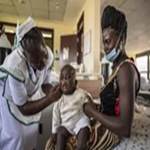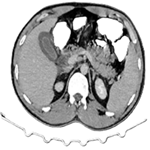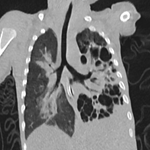Factors contributing to routine immunization performance in Ethiopia, 2014
Aschalew Teka Bekele, Braka Fiona, Karengera Thomas, Aron Kassahun, Gallagher Kathleen, Peter Nsubuga, Yohannes Ababu, Assefu Lemlem
Corresponding author: Aschalew Teka Bekele, Immunization programme, World Health Organization, Addis Ababa, Ethiopia 
Received: 04 Aug 2016 - Accepted: 23 Jan 2017 - Published: 09 Jun 2017
Domain: Epidemiology
Keywords: Ethiopia, Immunization performance, disparity, immunization coverage
This article is published as part of the supplement The Expanded Program on Immunization in Ethiopia, commissioned by The World Health Organization - Country Office for Ethiopia.
©Aschalew Teka Bekele et al. Pan African Medical Journal (ISSN: 1937-8688). This is an Open Access article distributed under the terms of the Creative Commons Attribution International 4.0 License (https://creativecommons.org/licenses/by/4.0/), which permits unrestricted use, distribution, and reproduction in any medium, provided the original work is properly cited.
Cite this article: Aschalew Teka Bekele et al. Factors contributing to routine immunization performance in Ethiopia, 2014. Pan African Medical Journal. 2017;27(2):5. [doi: 10.11604/pamj.supp.2017.27.2.10470]
Available online at: https://www.panafrican-med-journal.com//content/series/27/2/5/full
Factors contributing to routine immunization performance in Ethiopia, 2014
Aschalew Teka Bekele1,&, Braka Fiona1, Karengera Thomas1, Aron Kassahun1, Gallagher Kathleen1, Peter Nsubuga2, Yohannes Ababu1, Assefu Lemlem1
1Immunization programme, World Health Organization, Addis Ababa, Ethiopia, 2Medical Epidemiologist, Global Public Health Solutions LLC, Decatur GA, USA
&Corresponding author
Aschalew Teka Bekele, Immunization programme, World Health Organization, Addis Ababa, Ethiopia
Introduction: an increasing trend of routine immunization performance has generally been observed over the past decade in Ethiopia. However, the improvement is irregular with wide disparity among and within regions. This study analyzes health facility characteristics contribution to immunization performance in Ethiopia.
Methods: we conducted a cross-sectional study and compared characteristics of health facilities in good and poor performing zones. We used administrative coverage reports and Personal Digital Assisted (PDA) supervisory data collected by WHO EPI field officers using a standardized structured checklist. We selected 48 zones and 302 health facilities based on immunization performance data and supervisory data on potential variables.
Results: logistics regression was used to identify independent contributors to good immunization performance. On logistics regression we found that: actions by higher levels in conducting supervision (Odds Ratio (OR) =4.15. 95% Confidence Interval (CI) = 1.85, 9.32, p value <0.01] and providing written feedback (Odds Ratio (OR) =4.35. 95% Confidence Interval (CI) = 2.27, 8.33, p value <0.01) , and provision of immunization services by the health facility itself for catchment population under each health unit (Odds Ratio (OR) =20.15. 95% Confidence Interval (CI) = 2.24, 181.38, p value =0.01) and absence of stock out of vaccines (Odds Ratio (OR) =0.44. 95% Confidence Interval (CI) = 0.23, 0.83, p value =0.01) are the likely significant factors contributing to good immunization performance in Ethiopia.
Conclusion: ensuring availability of immunization services in all health facilities, regular supervision and written feedback and improved stock management are essential factors contributing to good immunization performance.
Immunization is one of the most effective public health interventions known so far [1,2]. In 2013, an estimated 2 to 3 million deaths globally were averted through immunization [3]. The Government of Ethiopia incorporated childhood vaccination in the Health Sector Development Plan (HSDP) as one of the key interventions to improve child health outcomes [4]. Progress was measured by proportion of under 1 year old children vaccinated with a third dose of diphtheria, pertussis and tetanus containing vaccine (DPT3) coverage which is the reference indicator of coverage for Expanded Programme on Immunization (EPI) [4,5]. Ethiopia adopted the Global Vaccine Action Plan (GVAP) targets to reach 90% DPT3 coverage nationally and 80% coverage at district level by 2015 [6]. Between 2004 and 2014 improvement in immunization coverage was observed globally and in Africa [7]. The DPT3 administrative coverage in Ethiopia increased reports from 66% to 87% in 2004 and 2014 respectively [8].
Based on administrative and World Health Organization (WHO)-United Nations Children's Fund (UNICEF) joint estimates, immunization performance in Ethiopia showed improvement from 2012-2014. However, variation and discrepancies within regions and zones still remained a challenge where in 2013 and 2014 the proportion of zones that achieved DPT3 vaccination coverage of at least 80% were 50% and 73% respectively [8]. To improve and sustain routine immunization (RI) coverage, woredas (which are equivalent to districts in Ethiopia) need a supportive political and policy context, as well as essential immunization infrastructure [9]. The success factors for the improved coverage in Africa as well as Ethiopia were attributed to implementation of the "Reach Every District" (RED) approach, support of global partners, use of community health workers, and expansion of the health infrastructure and the health system [9-11]. There is little published evidence of studies conducted in Africa to identify the reasons why some jurisdictions perform well in immunization activities while others do not despite being in the same country setting of infrastructure and socio-economic contexts [12]. We performed a cross-sectional study to compare good and poor performing zones based on the characteristics of immunization programme management by health facilities to identify possible contributing factors to RI improvement in Ethiopia. We believe that the study results and recommendations could be used to sustain improvement in good performing zones and scale up good practices in poor performing zones.
Study area and study period: Ethiopia is a country with a federal government composed of nine regional states and two city administrations. Regions are further sub-divided into 103 zones and 840 woredas which are equivalent to districts. As of 2014 the total population was estimated to be 89,714,313 with more than 3 million birth cohort targeted for immunization. Oromia, Amhara, Southern Nations and Nationalities People Region (SNNPR) and Tigray regions constitute more than 85% of the total population. There are over 3200 health centers and 15000 health posts and more than 90% of them provide immunization services. We collected data in July 2014 from 426 health facilities located in 53 zones to describe factors associated with good immunization performance in Ethiopia.
Study design: we conducted a cross-sectional study and compared characteristics of health facilities in good and poor performing zones to identify potential factors that contribute to immunization performance in Ethiopia.
Study population: we included 53 good and poor performing zones and studied characteristics of 426 health facilities that had data collected on the nine explanatory variables of this study: immunization service, session interruption, supervision, written feedback, defaulter tracking system, performance monitoring, vaccine stock status, availability of trained focal person and practice of informing care takers on key immunization messages. Health facilities from Harari region and Dire Dawa and Addis Ababa city administrations were not included as there was no supervisory data from these regions (Figure 1).
Inclusion criteria: we included zones with DPT3 coverage data for 2014 and health facilities with records on the nine independent variables.
Sample size: we selected 426 health facilities which had data on the nine explanatory variables and with available coverage data on third dose DPT3 coverage for their respective zones.
Data collection and measurement
Data source: we used the joint Federal Ministry of Health - WHO-UNICEF report for administrative (JRF 2014) and used supervision data stored in the WHO database for analysis of health facility characteristics. The supervisory data were collected during health facility visits by WHO EPI field officers using a standard checklist adapted by the central EPI team uploaded in a PDA. The checklist contained questions on surveillance and immunization activities. Data were submitted to the regional and central coordinators and cleaned by central data management team.
Study variables
Dependent variable: zone immunization coverage of third dose of diphtheria, pertussis and tetanus containing vaccines (DPT 3 coverage)
Independent variables: health facilities providing immunization service; health facilities that were supervised by higher level in the past 6 months; tracing of defaulters who missed their subsequent vaccination doses; monitoring immunization performance as evidenced by use of monitoring chart; stock out of any vaccine for any duration; presence of trained EPI focal point; written feedback given by higher levels; interruption of immunization session for any reason; are care takers informed on key immunization messages after vaccinating their children?
We obtained the data on the independent and dependent variables from the WHO databases which are maintained in MS-Excel. We also used administrative coverage reports and the WHO database for data on supervision.
Operational definitions: DPT 3 coverage: proportion of under 1-year old infants vaccinated with three doses of DPT (Diphtheria, Pertussis, Tetanus) containing vaccine. A good immunization-performing zone was defined as a zone with at least 80% DPT 3 coverage and a poor performing zone was defined as one with less than 80% DPT 3 coverage. The Global Immunization Vision and Strategy (GIVS) and the national immunization Comprehensive Multi-Year Plan (cMYP) 2011-2015 documents aim to achieve at least 80% DPT 3 coverage in 90% of districts. Therefore the cut-off for categorizing zones in to good and poor performing zones is based on the national and global targets.
Data analysis: we checked both administrative and supervisory data for cleanliness, accuracy and missing values. We used MS Excel and Epi Info 3.5.3 [13] for cleaning and further data analysis. We performed descriptive analysis of variables and checked completeness and frequency of each variable. We recoded variables into yes/no and conducted bivariate analysis and explored the presence of association between the independent variables and zone immunization coverage. We decided to consider variable with small p-value (p<0.1) for multivariate analysis of possible prediction of immunization performance, adjusted for the presence of other variables.
We analyzed data on immunization management from 426 health facilities located in eight Regions and 53 zones. Of these 38 (71%) were categorized as good performing zones while15 (29%) were categorized as poor performing zones (Table 1). Immunization sessions for catchment population were available in 396 (93%). Three hundred forty four (88%) and 166 (45.7%) facilities were supervised and given written feedback within the 6 months study period. There was no reported interruption of immunization sessions in 391 (94%) nor stock out of any vaccine in 264 (64%). Performance monitoring and defaulter tracing were observed in 207 (52%) and 217 (55%) health facilities respectively. Immunization sessions were observed in 116 (27.9%) of the facilities out of which 103 (88.8%) of vaccinators provided key EPI information to caretakers. Trained focal persons were available in-237 (56%) of the facilities (Table 2). Findings from bivariate analysis revealed strong association between DPT3 coverage and availability of immunization service in the facility [Odds Ratio (OR) =3.45. 95% Confidence Interval (CI) = 2.08,7.37, p value <0.01], written feedback [OR =5.72. 95% CI= 3.17, 10.32, p value <0.001], supervision of health facilities by woredas or zones [OR =3.92. 95% CI= 2.08 7.37, p value 0.001] and stock out of vaccine [OR =0.38. 95% CI= 0.24, 0.61, p value 0.001] (Table 3).
Logistic regression analysis revealed that, based on our categorization of good performance, DPT3 coverage was 7.16 and 4.35 times greater respectively in zones that conducted supportive supervision within the preceding 3-6 months (95%CI=1.92, 26.26, p value 0.00) and provided written feedback to their health facilities (95%CI =2.27, 8.33, p value 0.00). The DPT3 coverage was 20.15 times greater in zones where the health facilities had immunization services (95%CI=2.24, 181.38, p value 0.01) and 4.1 times greater where health facilities monitored their immunization performance (95%CI =1.2, 14.05, p value 0.02). The DPT3 coverage was 0.44 times lesser in zones where health facilities had stock out of vaccines (OR 0.44 95%CI = 0.23-0.83, p value 0.01) (Table 4).
In our analysis of factors associated with good performance of RI, we found availability of immunization sessions, supervision, written feedback, performance monitoring and stock out of vaccines to be strong predictors of immunization coverage in Ethiopia [9,14-16]. Written feedback, supportive supervision, availability of immunization services in all health facilities and performance monitoring were associated with good performance. Stock out of vaccine was associated with poor performance[14,15,17]. In our logistic regression analysis, we also found that performance monitoring was associated with good immunization performance though this was not observed on bivariate analysis[18]. We also observed that stock out of vaccines other than DPT containing vaccines were associated with poor DPT3 coverage containing vaccine probably through interruption of session until all antigens are ready for immunization sessions [14,19].
To our surprise, we did not observe any association between coverage and the following characteristics: provision of key EPI messages to care takers, availability of trained EPI focal person and interruption of session and defaulter tracking. We considered that the association between coverage and provision of key messages might have been affected due to observation of inadequate immunization sessions [18,20]. Generalization of our findings to other contexts may be limited by the following: we conducted cross-sectional study which may not be a preferred method for comparison analysis. However, we analyzed variables with p-value <0.1 and explored factors contributing to immunization performance. Data from the two city administrations (Addis Ababa and Dire Dawa) and Harari region was not available. However, data were available from the remaining regions and we included urban zones in our analysis.
In conclusion, though we did not include all potential predictor variables in the study, we found that the way health facilities manage immunization programme and the supportive function of higher levels are predictors of immunization performance of zones in Ethiopia. We recommend that administrative health offices should provide regular written feedback and enforce provision of immunization service in all health facilities where there are adequate immunization system inputs. We further recommend that stock management should improve at all levels and the negative impact of stock out of vaccines other than pentavalent should be noted; therefore stock management should aim at improving availability of all vaccines at all times. We also recommend regular supervision of health facilities which provides the opportunity to identify and rectify gaps as they occur. We also recommend further study incorporating other potential variables and more settings to gather more evidence in Ethiopia.
What is known about this topic
- While there is adequate information on the importance of conducting supportive supervision to health units and provision of feedback, little is documented about the contribution of such actions to improve immunization performance;
- Most studies focus on identifying challenges to immunization performance and try to forward recommendations to increase coverage by removing the identified challenges than focusing on identifying the positive factors that contribute to better performance;
- Little effort is made to understand why some areas perform well compared to the others while being under the same socio-economic and political environment.
What this study adds
- This study gives a different perspective as to looking at the factors that contribute to immunization by trying to understand the positive attributes than focusing on challenges;
- This study also gives evidence that the actions of the higher levels such as supervision and written feedback when done regularly and properly can influence performance positively;
- The study provides evidence as to the contribution of health facility characteristics to immunization performance apart from the experience and characteristics of service providers and service users.
The authors declare no competing interests. The views expressed in the perspective articles are those of the authors alone and do not necessarily represent the views, decisions or policies of the institutions with which they are affiliated and the position of World Health Organization.
Aschalew Teka: made substantial contribution in manuscript design, data compilation, analysis, write up and finalization of manuscript. Braka Fiona: made substantial contribution in manuscript design write up and finalization of manuscript. Karengera Thomas: contributed to manuscript design in write up and finalization of manuscript. Aron Kassahun: made significant contribution in data compilation and analysis. Gallagher Kathleen: made significant contribution in manuscript design, edition and finalization. Peter Nusubuga: made significant contribution in manuscript design, data analysis and editing. Yohannes Ababu: contributed in write up and data analysisAssefu Lemlem: contributed in write up and finalization. All authors have read and approved the final version of the manuscript.
We would like to extend our special acknowledgements to the WHO Country Office, Addis Ababa for providing the necessary support in the process of writing in this manuscript writing.
Table 1: regional distribution of supervised facilities in Ethiopia, 2014
Table 2: characteristics of supervised facilities by selected variables, Ethiopia, 2014
Table 3: association of supervisory characteristics with DPT-HIB-HepB 3 coverage, Ethiopia, 2014
Table 4: logistic regression analysis of variables with strong association as predictors for DPT-HIB-HepB3 performance, Ethiopia, 2014
Figure 1: map of good and poor performing zones in Ethiopia, 2014
- WHO, UNICEF. GIVS: Global Immunization Vision and Strategy 2006-2015. Accessed on August 04 2016.
- Bustreo F, J-M Okwo-Bele, Kamara L. World Health Organization perspectives on the contribution of the Global Alliance for Vaccines and Immunization on reducing child mortality Arch Dis Child 2015;100(Suppl 1):s34–s37. PubMed | Google Scholar
- Cherian T, Okwo-Bele J-M. The decade of vaccines global vaccine action plan: shaping immunization programmes in the current decade. Expert Rev Vaccines. 2014; 13(5): 573-5. PubMed | Google Scholar
- UNDP. Analyzing Regional Performance and Disparities in Health Outcomes in Ethiopia. 2012. Accessed on 4 August 2016.
- Kamara L, Lydon P, Bilous J, Vandelaer J, Eggers R, Gacic-Dobo M et al. Global immunization vision and strategy (GIVS): a mid-term analysis of progress in 50 countries. Health Policy Plan. 2013; 28(1): 11-9. PubMed | Google Scholar
- Brown DW, Burton A, Gacic-Dobo M, Karimov RI, Vandelaer J, Okwo-Bele J. A mid-term assessment of progress towards the immunization coverage goal of the Global Immunization Vision and Strategy (GIVS). BMC Public Health. 2011; 11: 803. PubMed | Google Scholar
- UNICEF W and. Ethiopia -WHO and UNICEF estimates of immunization coverage: 2014 revison. pdf. 2015. Accessed on August 04 2016. Google Scholar
- LaFond AK, Sequeria J. Drivers of routine immunization system performance at the District level: Ethiopia case study. ARISE Res Br. 2009; 2: 2. Google Scholar
- LaFond AK, Kanagat N, Sequeira JS, Steinglass R et al. Drivers of Routine Immunization System Performance at the District Level:Study Findings from Three Countries, Research Brief No3. 2012. Accessed on 4 August 2016.
- FMOH-Ethiopia. Ethiopia's Health Sector: Excellent Return on Your Development Funding. 2013.
- Lakew Y, Bekele A, Biadgilign S. Factors influencing full immunization coverage among 12-23 months of age children in Ethiopia: evidence from the national demographic and health survey in 2011. BMC Public Health. 2015 Jul 30; 15: 728. PubMed | Google Scholar
- CDC. Epi Info . Accessed on 4 August 2016
- Favin M, Steinglass R, Fields R, Banerjee K, Sawhney M. Why children are not vaccinated?: a review of the grey literature. Int Health Royal Society of Tropical Medicine and Hygiene. 2012; 4(4): 229-38. PubMed | Google Scholar
- Community E. H ealth S ystem and Notes from the field: 2012;1-6. Google Scholar
- Kahn JG, Mokdad AH, Deming MS, Roungou J, Boby AM, Excler J et al. Avoiding missed opportunities for immunization in the Central African Republic: potential impact on vaccination coverage. Bull World Health Organ. 1995; 73(1): 47-55. PubMed | Google Scholar
- Duclos P, Okwo-Bele J-M, Gacic-Dobo M, Cherian T. Global immunization: status, progress, challenges and future. BMC Int Health Hum Rights. 2009; 9(Suppl 1): S2. PubMed | Google Scholar
- Berhane Y, Masresha F, Zerfu M, Birhanu M, Kebede S, Shashikant S. Status of expanded program on immunization in a rural town--south Ethiopia. Ethiop Med J. 1995 Apr; 33(2): 83-93. PubMed | Google Scholar
- Bicaba A, Haddad S, Kabore M, Taminy E, Feletto M, Fournier P. BMC International Health and Monitoring the performance of the Expanded Programme on Immunization: the case of Burkina Faso. BMC. 2009; 9: 1-9. PubMed | Google Scholar
- Mitchell S, Andersson N, Ansari NM, Omer K, Soberanis JL, Cockcroft A. Equity and vaccine uptake: a cross-sectional study of measles vaccination in Lasbela District, Pakistan. BMC Int Health Hum Rights. 2009 Jan; 9(Suppl 1): S7. PubMed | Google Scholar
Search
This article authors
On Pubmed
On Google Scholar
Citation [Download]
Navigate this article
Similar articles in
Key words
Tables and figures
This supplement
- Measles outbreak investigation in Guji zone of Oromia Region, Ethiopia (Accessed 613 times)
- Introducing an accountability framework for polio eradication in Ethiopia: results from the first year of implementation 2014-2015 (Accessed 540 times)
- Measles burden in urban settings: characteristics of measles cases in Addis Ababa city administration, Ethiopia, 2004-2014 (Accessed 511 times)
- Effects of polio eradication activities on routine immunization: lessons from the 2013 outbreak response in Somali region of Ethiopia (Accessed 505 times)
- Behavioral determinants of immunization service utilization in Ethiopia: a cross-sectional community-based survey (Accessed 503 times)
- Factors contributing to routine immunization performance in Ethiopia, 2014 (Accessed 501 times)
- Assessment of reporting sites for acute flaccid paralysis surveillance in Ethiopia: implications for planning of active case search visits (Accessed 478 times)
- Assessment of source of information for polio supplementary immunization activities in 2014 and 2015, Somali, Ethiopia (Accessed 477 times)
- Analysis of acute flaccid paralysis surveillance in Ethiopia, 2005-2015: progress and challenges (Accessed 472 times)
- Status of surveillance and routine immunization performances in Amhara Region, Ethiopia: findings from in-depth peer review (Accessed 460 times)
- Health care seeking behavior of parents with acute flaccid paralysis child (Accessed 452 times)
- Status of surveillance and routine immunization performances in Amhara Region, Ethiopia: findings from in-depth peer review (Downloaded 165 times)
- Effects of polio eradication activities on routine immunization: lessons from the 2013 outbreak response in Somali region of Ethiopia (Downloaded 121 times)
- Measles outbreak investigation in Guji zone of Oromia Region, Ethiopia (Downloaded 114 times)
- Behavioral determinants of immunization service utilization in Ethiopia: a cross-sectional community-based survey (Downloaded 108 times)
- Introducing an accountability framework for polio eradication in Ethiopia: results from the first year of implementation 2014-2015 (Downloaded 98 times)
- Factors contributing to routine immunization performance in Ethiopia, 2014 (Downloaded 97 times)
- Measles burden in urban settings: characteristics of measles cases in Addis Ababa city administration, Ethiopia, 2004-2014 (Downloaded 96 times)
- Assessment of source of information for polio supplementary immunization activities in 2014 and 2015, Somali, Ethiopia (Downloaded 89 times)
- Analysis of acute flaccid paralysis surveillance in Ethiopia, 2005-2015: progress and challenges (Downloaded 86 times)
- Assessment of reporting sites for acute flaccid paralysis surveillance in Ethiopia: implications for planning of active case search visits (Downloaded 84 times)
- Health care seeking behavior of parents with acute flaccid paralysis child (Downloaded 75 times)











